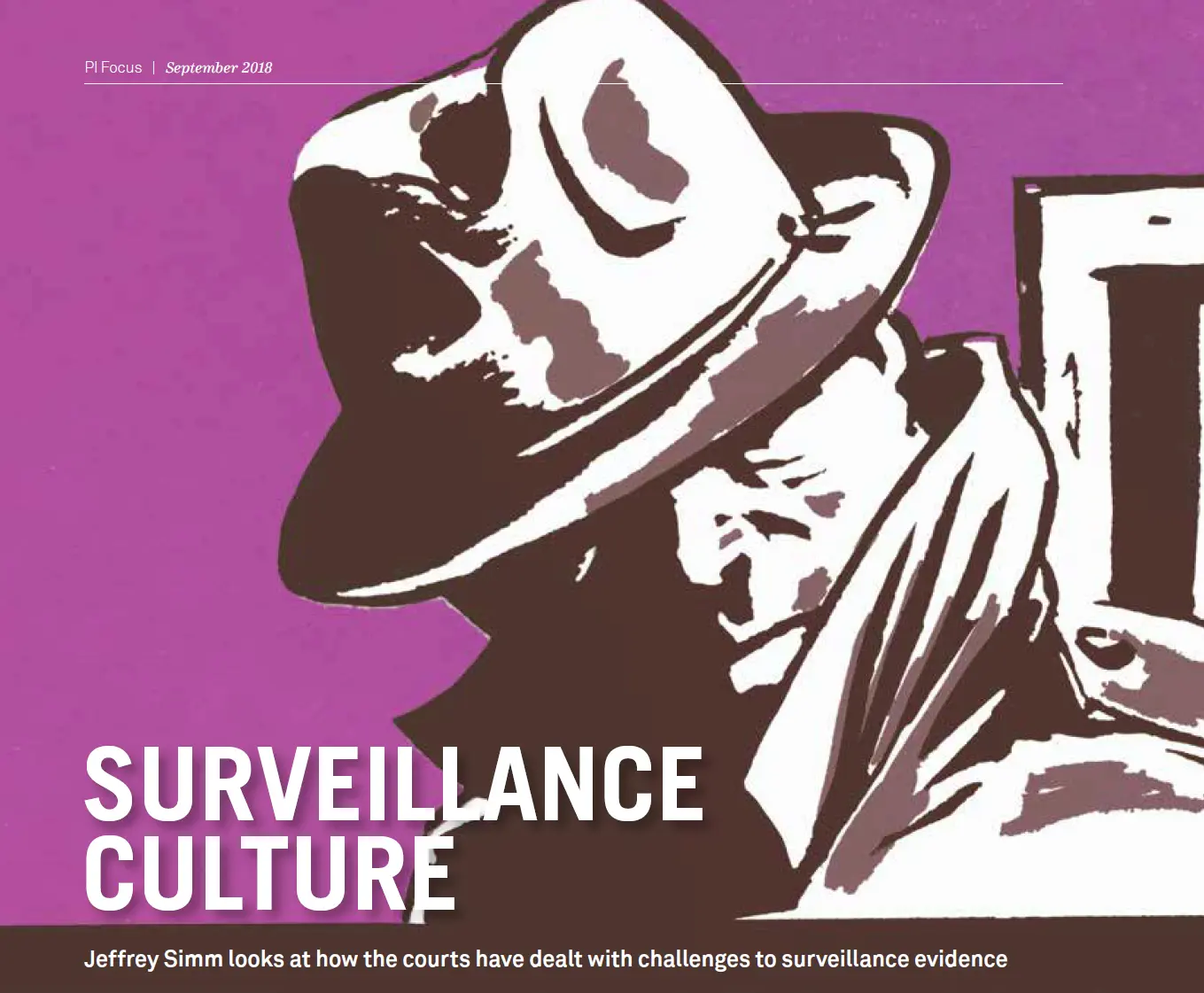I last wrote about insurance company-instructed covert surveillance back in 2013. In that article (PI Focus, October 2013, page 12), I voiced my concern about the unsavoury and unethical tactics being routinely used by both the private investigation firms instructed to gather the evidence and those individuals tasked with the actual filming of the claimant.
The article followed my input in Samson v Ali [2012] EWHC 4146 (QB), heard at The Royal Courts of Justice. In that case, the insurers (Aviva) sought to debar the claimant from relying on my expert evidence, but Mr. Justice Stadlen granted permission to call the evidence at trial. That evidence highlighted manipulation of the film that had been presented at a higher-than-real-time frame rate, giving the impression that Ms. Samson moved with a much greater fluidity of movement than was actually the case.
In the article, I further expressed the need for a judicial change in the way video evidence is instructed, obtained, and delivered. I proposed a simple and easily implemented procedural change that would instantly make all video evidence more reliable, fair, and time- and cost-effective for all parties. A change that would not alter the course of the surveillance itself or what was filmed, but would mean that the claimant, the experts, the lawyers, and the courts could agree on it and rely on it at a much earlier stage—thus reducing both time and, subsequently, costs.
Licensing of private investigators was, at my last time of writing, very much at the forefront of the minds of key members of Parliament tasked with bringing in legislation. But since 2013, the once right honourable former chair of The Home Affairs Select Committee, Keith Vaz MP, has had some personal distractions to deal with, and the then Home Secretary, Theresa May’s, thoughts also, I hazard a guess, may be elsewhere at the moment.
So it is that in the past five years, really nothing has changed. The whole surveillance industry remains completely unregulated, and even the courts seem not to know what is and what is not expert evidence when it comes to the revelation of misconduct and manipulation in all matters of surveillance.
The Association of British Investigators currently states on its homepage:
“There’s no denying, private investigation can be a minefield. The market is unregulated, and plagued by rogue operators. And that makes life difficult for everyone concerned.”
Recent Cases
Some recent cases that I have been instructed in serve to highlight the current confusion over the gathering and presentation of covert surveillance evidence.
In Chadwick v Lewis & Aviva Insurance Ltd (2016), the claimant argued that the wiping of the SD cards was in breach of the ABI (Association of British Insurers) guidelines, which stated:
“The original VD/CD/memory stick should be from virgin stock (i.e., new and unused); the original media should never be edited under any circumstances, but copied to provide working copies, and the original media should be labeled, sealed, and numbered as an exhibit and retained securely for production in court or forensic examination as necessary.”
The claimant argued that the defendant’s representatives should have been aware of these guidelines and instructed enquiry agents to retain the SD cards. The claimant’s argument was strengthened by the fact that the lawyers representing Aviva were DWF, which had told Insurance Post (June 2016) that:
“DWF has worked with the ABI for many years and we are pleased to be able to strengthen our relationship by becoming an Associate Member, enabling the firm to work even more closely with the insurance industry.”
The judge duly refused permission for the defendants to rely on the video evidence, stating:
“If (a claimant) is not able to see the original documents and satisfy himself or herself as to their efficacy, so that they are available, and what the content shows, then it seems to me that the effect of a video which may or may not show the complete picture is not going to have a great deal of assistance for the Court because cross-examination is not going to assist.”
The defendants appealed, and the matter came before His Honour Judge Keyser QC on 1 August 2016. The defendant submitted that the surveillance was admissible and the fact the SD card had been wiped did not justify an exclusionary approach. Allowing the defendant’s appeal, the judge held:
“That in focusing on the wiped SD cards, the district judge had taken a mistaken approach. The defendant was not seeking permission to rely on the SD cards but rather on the edited and unedited surveillance.”
While I can, to a certain degree, understand from where the judge formed his opinion, I feel that he failed to recognise one crucial element: what is not shown on the film is often equally—and on occasion more—important than what is shown.
To highlight this, I refer to another case in which I was instructed and retained, Hayden v NHS [2016] EWHC 3276 (QB). While analyzing the footage and accompanying documentation, I discovered that one of the defendant’s medical professionals had formed an opinion on a potentially crucial section of film that was then subsequently missing from the purportedly original unedited SD Cards that I had had sight of.
In his judgment, Mr. Justice Jay stated:
“It came out in evidence that five digital files are missing: in other words, that five files have, for whatever reason, not been downloaded onto the head office computer of Robertson & Co, the entity under whose auspices the evidence was obtained.”
The judge continued:
“There is a regrettable error in one of the surveillance logs. The log for 22nd February 2016 states, at 15:07, ‘subject exits in the motor vehicle’. The DVD does not show this.”
He further remarked:
“In my judgment, if evidence of this sort is going to be deployed in court, a greater level of care than was exercised in this case should be taken to ensure its complete accuracy.”
A Widespread Problem
I see manipulation of film and documentation in potentially life-changing cases on an uncomfortably regular basis, and it is clear—not only to me but also, it seems, to the courts and The Association of British Investigators—that these tactics are not just being deployed by a few rogue operatives but are rife throughout the industry. An industry that is at the very sharp end of determining the life prospects for those unfortunate enough to have suffered injury or negligence.
There is an ongoing debate on whether video evidence analysis experts such as myself are indeed experts or not. It is also apparent that much time and money is being spent arguing over this, and it seems to me that, as it stands, insurers are instructing solicitors who then use counsel to present evidence to the courts, which are really not sure whether the evidence is expert or not. Are the surveillance operatives who gather the film experts? Am I an expert?
Final Advice
With modern technology and correctly trained and experienced operatives, it really is very easy to observe and film a suspected fraudulent claimant. It is also very straightforward to compile a paper trail to back up the gathered evidence, and it is only the work of a moment to ensure that the original evidence (SD Cards) is securely retained.
In light of the current situation, which is unlikely to change, my advice is that, should you be the recipient of surveillance evidence, then always request:
- Witness statements confirming the role of each surveillance operative, what they witnessed, and what they filmed.
- Confirmation that the original recording media (SD Cards) have been retained.
- Copies of all edited footage.
- Copies of all unedited footage.
- Contemporaneous surveillance operatives’ notes.
- A typed surveillance report.
On receipt of these, you should view in full all the footage and advise your client to do the same. If you then have any suspicions that the evidence may not be a true reflection of your client, consider instructing—if such a person exists—a covert video evidence analysis expert to uncover the true picture.
An article by Jeff Simm of Lumina Surveillance Group

